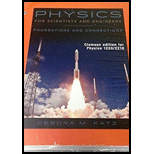
Concept explainers
The energy required to transform an ice cube to steam.
Answer to Problem 27PQ
The energy required to transform an ice cube to steam is
Explanation of Solution
Given that the mas of the ice is
The energy required to transform ice to steam is to be found. It is the sum of the energy required to reach the melting point, energy required to melt the ice, energy required to reach the boiling point, energy required to vaporize the water, and the energy required to raise the temperature of the vapour to
Write the expression for energy required to reach the melting point of the ice.
Here,
Write the expression for energy required for the melting of ice.
Here,
Write the expression for the energy required to reach the boiling point of water.
Here,
Write the expression for the energy required to vaporize the water at its boiling point.
Here,
Write the expression for the heat energy required to raise the vapour to
Here,
Write the expression for the total energy required to transform the ice to steam.
Conclusion:
Substitute
Substitute
Substitute
Substitute
Substitute
Substitute
Therefore, the energy required to transform an ice cube to steam is
Want to see more full solutions like this?
Chapter 21 Solutions
Physics for Scientists and Engineers: Foundations and Connections
- One of a dilute diatomic gas occupying a volume of 10.00 L expands against a constant pressure of 2.000 atm when it is slowly heated. If the temperature of the gas rises by 10.00 K and 400.0 J of heat are added in the process, what is its final volume?arrow_forwardWhat is the internal energy of 6.00 mol of an ideal monatomic gas at 200 ?arrow_forwardIf a gas is compressed isothermally, which of the following statements is true? (a) Energy is transferred into the gas by heat. (b) No work is done on the gas. (c) The temperature of the gas increases. (d) The internal energy of the gas remains constant. (e) None of those statements is true.arrow_forward
- A 1.00-mol sample of hydrogen gas is heated at constant pressure from 300 K to 420 K. Calculate (a) the energy transferred to the gas by heat, (b) the increase in its internal energy, and (c) the work done on the gas.arrow_forwardFor a temperature increase of 10 at constant volume, what is the heat absorbed by (a) 3.0 mol of a dilute monatomic gas; (b) 0.50 mol of a dilute diatomic gas; and (c) 15 mol of a dilute polyatomic gas?arrow_forwardAn ideal gas initially at 300 K undergoes an isobaric expansion at 2.50 kPa. If the volume increases from 1.00 m3 to 3.00 m3 and 12.5 kJ is transferred to the gas by heat, what are (a) the change in its internal energy and (b) its final temperature?arrow_forward
- When a gas undergoes an adiabatic expansion, which of the following statements is true? (a) The temperature of the gas does not change. (b) No work is done by the gas. (c) No energy is transferred to the gas by heat. (d) The internal energy of the gas does not change. (e) The pressure increases.arrow_forwardAn ideal gas is enclosed in a cylinder with a movable piston on top of it. The piston has a mass of 8 000 g and an area of 5.00 cm2 and is free to slide up and down, keeping the pressure of the gas constant. How much work is done on the gas as the temperature of 0.200 mol of the gas is raised from 20.0C to 300C?arrow_forwardWhen 400 J of heat are slowly added to 10 mol of an ideal monatomic gas, its temperature rises by 10 . What is the work done on the gas?arrow_forward
- A fire breaks out and increases the Kelvin temperature of a cylinder of compressed gas by a factor of 1.2. What is the final pressure of the gas relative to its initial pressure?arrow_forwardat 1 atm pressure, the latent heat of fusion of water is 334 kj/kg and the latent heat of vaporization is 2257 kj/kg. How much heat is needed to melt 2 kg of ice water without change in temperature?arrow_forwardHow much energy is required to change a 50g ice cube from ice at -15 degrees celcius to steam at 135 degrees celcius?arrow_forward
 Principles of Physics: A Calculus-Based TextPhysicsISBN:9781133104261Author:Raymond A. Serway, John W. JewettPublisher:Cengage Learning
Principles of Physics: A Calculus-Based TextPhysicsISBN:9781133104261Author:Raymond A. Serway, John W. JewettPublisher:Cengage Learning
 An Introduction to Physical SciencePhysicsISBN:9781305079137Author:James Shipman, Jerry D. Wilson, Charles A. Higgins, Omar TorresPublisher:Cengage Learning
An Introduction to Physical SciencePhysicsISBN:9781305079137Author:James Shipman, Jerry D. Wilson, Charles A. Higgins, Omar TorresPublisher:Cengage Learning Physics for Scientists and Engineers: Foundations...PhysicsISBN:9781133939146Author:Katz, Debora M.Publisher:Cengage Learning
Physics for Scientists and Engineers: Foundations...PhysicsISBN:9781133939146Author:Katz, Debora M.Publisher:Cengage Learning



